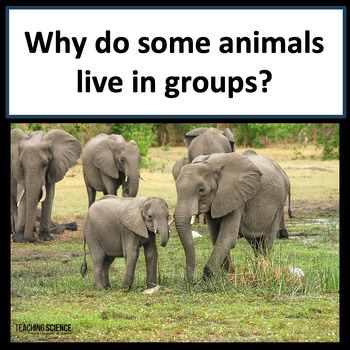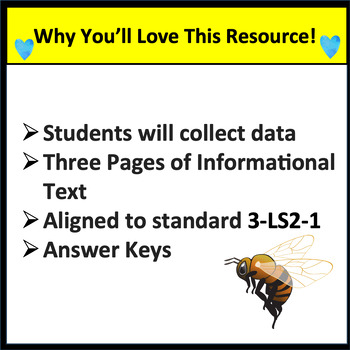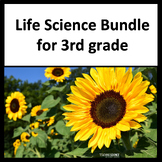Animal Groups Adaptations Animals Live in Groups to Help Them Survive 3rd Grade
- PDF
What educators are saying
Also included in
- This resource includes all of my resources for 3rd-grade NGSS Life Science. This collection of resources covers the life science standards for NGSS. Students will explore in hands-on, inquiry-based lessons. Students will read nonfiction scientific passages in a close reading format. They will responPrice $39.00Original Price $48.75Save $9.75
- This third-grade science bundle includes all of my resources for third-grade NGSS,as well as third-grade resources for reading informational text. Save 20% by purchasing this huge bundle. Teachers and school districts will love this third-grade Huge NGSS Bundle with a wide variety of labs, centers,Price $118.16Original Price $147.70Save $29.54
- This Bundle for Utah SEEd 3rd grade includes science resources for each strand and standard. Each unit included addresses specific Utah SEEd standards for 3rd grade. You save 20% by purchasing this bundle. You save time by purchasing this from someone who understands Utah SEEd. Would you like to kPrice $56.84Original Price $71.05Save $14.21
- Do you teach 3rd grade science? Students will love these engaging third-grade science lessons. Each unit meets one or more of the NGSS third-grade standards. Are you looking for resources made by someone who understands NGSS? This bundle covers all the standards for NGSS 3rd grade for the entire yeaPrice $72.36Original Price $89.55Save $17.19
Description
Why do animals live in groups? Animal groups are sometimes formed to help animals survive. Animals live in groups for different reasons. Students will collect data and construct an argument to support claims about why animals live in groups. This includes a high-interest informational text passage with great comprehension questions! Parts of this resource can be used as a Distance Learning Packet. This resource addresses the third-grade NGSS 3-LS2-1
This resource includes:
- a hands-on science activity
- charts
- 3-page informational text passage
- response pages with text-dependent questions
- two lesson plans
- a fun page on collective nouns
- answer keys
Great Reviews!
Meghan ⭐️ ⭐️ ⭐️ ⭐️ ⭐️ Extremely Satisfied
I realized that my science unit was missing this specific standard. I was so glad to find this one. The kids really enjoyed it as well. Thanks!
Dale ⭐️ ⭐️ ⭐️ ⭐️ ⭐️ Extremely Satisfied
Very pleased with this purchase. My students loved the labs, and I loved the questions that made them think critically about why animals live in groups!
See more about how to use this resource here Animals Live In Groups
This resource is designed to address the NGSS Disciplinary Core Idea of Ecosystem: Interactions, Energy, and Dynamics.
NGSS 3-LS2-1 Construct an argument that some animals form groups that help members survive.
and
Utah SEEdnStandard 3.2.4
Construct an explanation showing how variations in traits and behaviors can affect the ability of an individual to survive and reproduce. Examples of traits could include large thorns protecting a plant from being eaten or strong-smelling flowers to attracting certain pollinators. Examples of behaviors could include animals living in groups for protection or migrating to find more food. (LS2.D, LS4.B)
This integrated science and literacy lesson will address fully the NGSS standards while also addressing CCSS for reading informational text.
Students will learn that animals live in groups for several reasons. Animals living in groups help members to survive.
The following Science and Engineering Practices will be used by students:
Asking questions (for science) and defining problems (for engineering)
Developing and using models
Planning and carrying out investigations
Analyzing and interpreting data
Constructing explanations for science
Engaging in argument from evidence
Obtaining, evaluating, and communicating information
Science Topics Include:
Animal groups
Reasons for Animals to Live In Groups
Benefits to Species by Living in Groups
Collective Hunting
Shared Raising of the Young
Protection from Predators
Social Insects
Division of Labor
Herd Animals
Observation
Collecting Evidence
Recording Data
Supporting Claims with Evidence
Save 20% by purchasing in the Utah SEEd third-grade bundle.
Save 20% by purchasing in the NGSS third-grade bundle.
By Lynda R. Williams
Please note that the slide shows and pages are not editable. They are secure and protected by copyright. This resource is created by Teaching Science with Lynda R. Williams
If you have questions about my resources please contact me at lywilliams1@gmail.com
These resources are created by Lynda R. Williams at Teaching Science
- Follow me and get news of my new resources.
- Each new resource is discounted by 50% for the first 24 hours!
Students love my reading comprehension passages and questions! If you like this resource you should see some of my other resources for 3rd grade:









